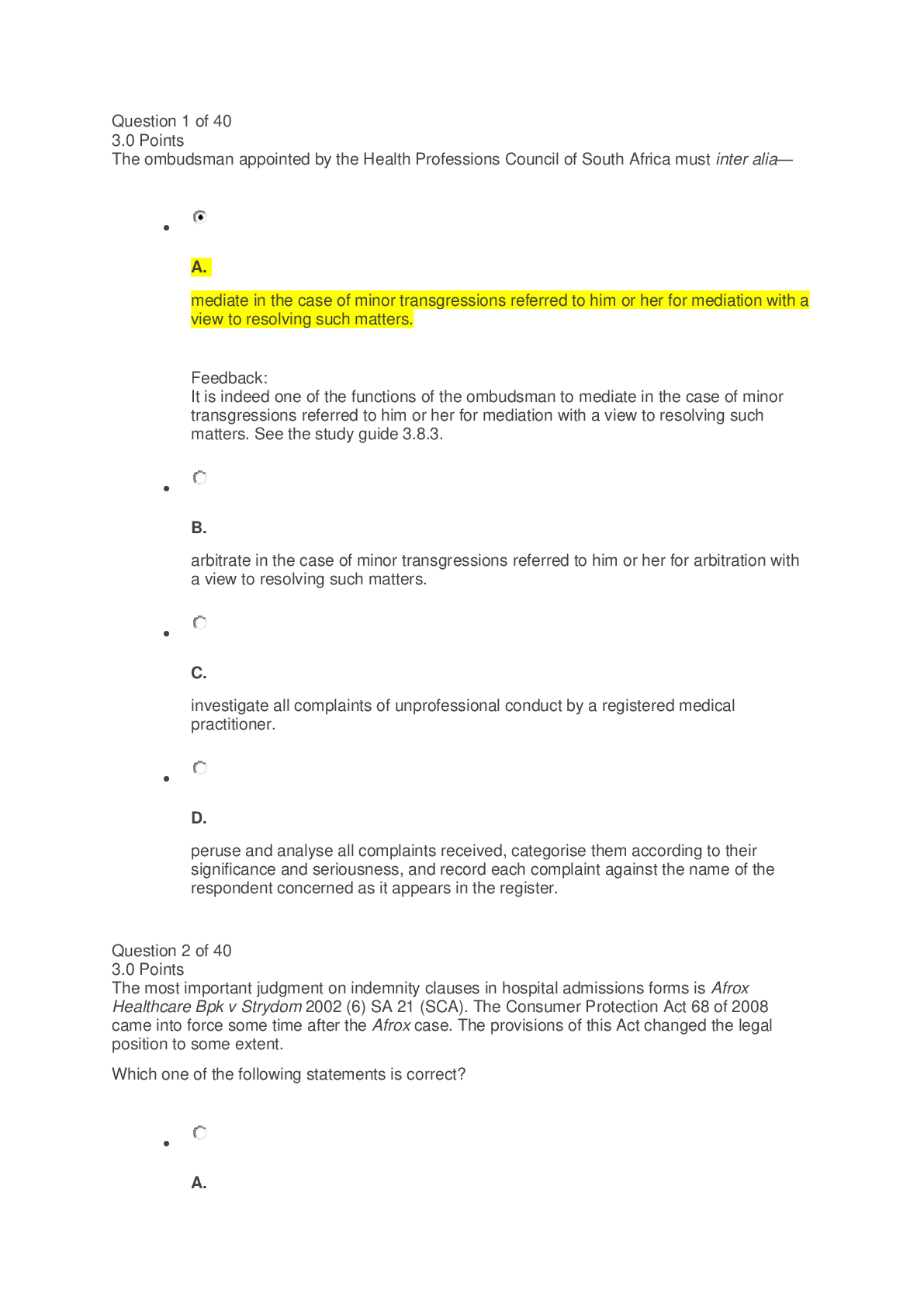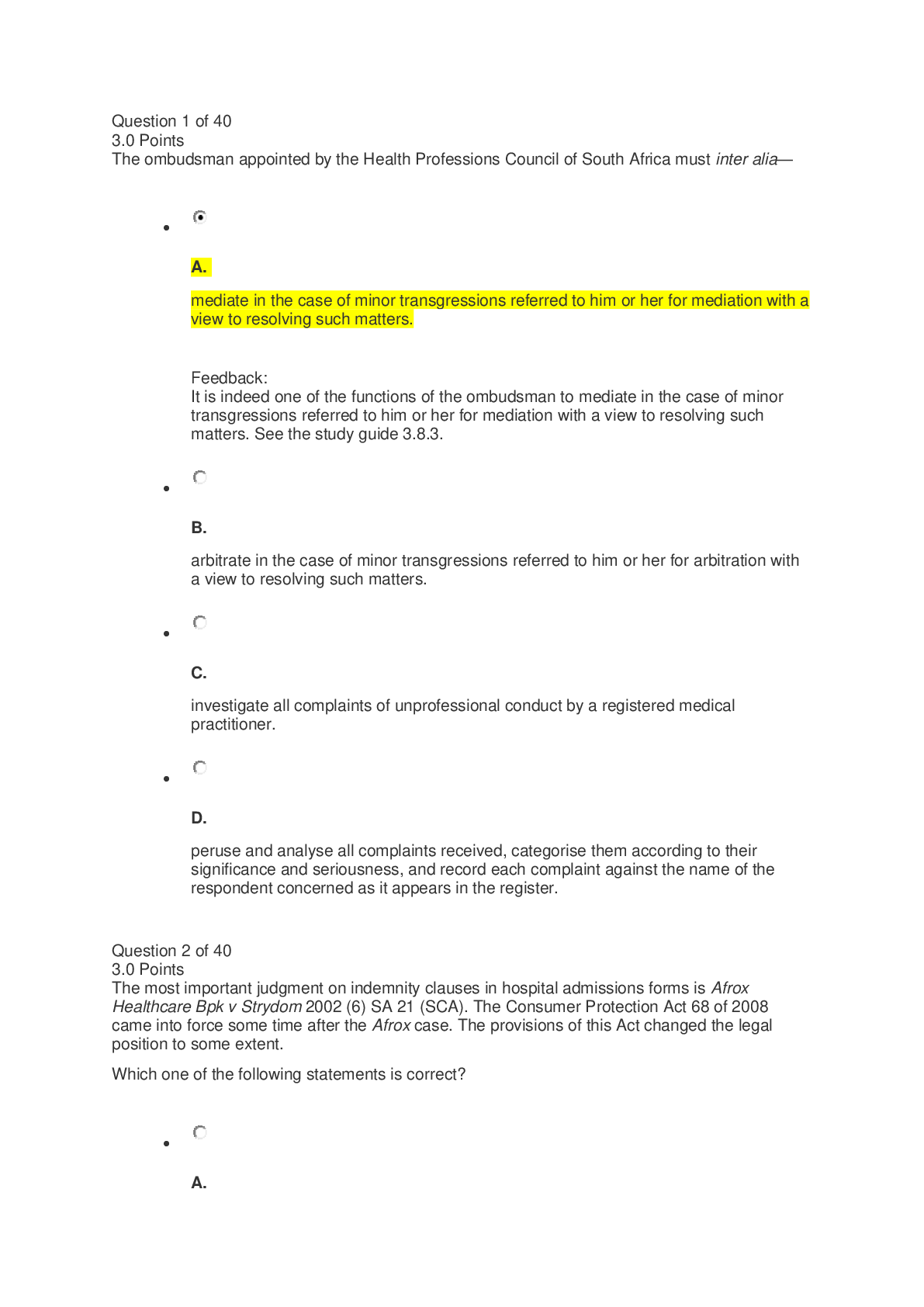Question 1 of 40
3.0 Points
The ombudsman appointed by the Health Professions Council of South Africa must inter alia—
A.
mediate in the case of minor transgressions referred to him or her for mediation with a
view to resolving such matters.
Feedback:
It is indeed one of the functions of the ombudsman to mediate in the case of minor
transgressions referred to him or her for mediation with a view to resolving such
matters. See the study guide 3.8.3.
B.
arbitrate in the case of minor transgressions referred to him or her for arbitration with
a view to resolving such matters.
C.
investigate all complaints of unprofessional conduct by a registered medical
practitioner.
D.
peruse and analyse all complaints received, categorise them according to their
significance and seriousness, and record each complaint against the name of the
respondent concerned as it appears in the register.
Question 2 of 40
3.0 Points
The most important judgment on indemnity clauses in hospital admissions forms is Afrox
Healthcare Bpk v Strydom 2002 (6) SA 21 (SCA). The Consumer Protection Act 68 of 2008
came into force some time after the Afrox case. The provisions of this Act changed the legal
position to some extent.
Which one of the following statements is correct?
A.
It is still unnecessary for a hospital (service provider) to draw the patient‘s
(consumer‘s) attention to an indemnity clause contained in a hospital admissions
form.
B.
Since the coming into operation of the Consumer Protection Act 68 of 2008, an
indemnity clause contained in a hospital admission form is always null and void and
unenforceable.
C.
It is still uncertain whether an indemnity clause purporting to exempt a hospital
(service provider) from liability for any loss attributable to the gross negligence of the
hospital is valid and enforceable.
D.
Since the coming into operation of the Consumer Protection Act 68 of 2008, an
indemnity clause purporting to exempt a hospital (service provider) from liability for
any loss attributable to gross negligence on its part is void to the extent that it
contravenes the provisions of the Act.
Feedback:
See 4.1.2.3 of the study guide.
The Consumer Protection Act answers the question that was left hanging in Afrox,
namely whether an indemnity clause could be applied to avoid liability for gross
negligence. Section 51(1)(c) now provides that a supplier must not make a transaction
or agreement subject to any term or condition purporting to limit or exempt a supplier
of goods or services from liability for any loss directly or indirectly attributable to
the gross negligence of the supplier or any person acting for or controlled by the
supplier. Section 51(3) of the Act makes it clear that such a purported term or
condition of a transaction or agreement, or notice to which a transaction or agreement
is purported to be subject, is void to the extent that it contravenes section 53.
Question 3 of 40
3.0 Points
Clarke v Hurst NO 1992 (4) SA 630 (D) confirms that passive euthanasia—
A.
cannot, in law, be regarded as the cause of the patient‘s death.
B.
can be executed lawfully only if the patient is already brain dead.
C.
would be lawful if it gives effect to the deceased‘s wishes as expressed in a living will.
D.
might be lawful if the person whose death is in question enjoys a very poor quality of
life.
Feedback:
Clarke v Hurst NO 1992 (4) SA 630 (D) confirms that passive euthanasia might be
lawful if the person whose death is in question enjoys a very poor quality of life. See
6.2.3.2 of the study guide. The court stated as follows: ―The decision whether the
discontinuance of the artificial nutritioning of the patient and his resultant death would
be wrongful, depends on whether, judged by the boni mores of our society, it would
be reasonable to discontinue such nutritioning. This decision relates to the quality of
life that the patient still enjoys.‖
Question 4 of 40
3.0 Points
In S v Hartmann 1975 (3) SA 532 (C) a medical practitioner took the life of his father who had
been suffering severely. This was an instance of—
A.
active euthanasia on request of the patient, resulting in an acquittal on the charge of
murder.
B.
active euthanasia resulting in a conviction of culpable homicide.
C.
active euthanasia performed on the patient‘s request, resulting in conviction of
culpable homicide.
D.
passive euthanasia resulting in a conviction of murder.
E.
active euthanasia resulting in a conviction of murder.
Feedback:
Correct. Note that Hartmann was convicted of murder, not culpable homicide. See the
study guide 6.2.3.1 and note the hint in the orange block.
Question 5 of 40
3.0 Points
A patient is suffering from an incurable disease accompanied by excruciating pain.
In which of the following scenarios is the doctor‘s conduct most likely to be considered lawful?
A.
Because of resistance consequent upon the habitual administering of an analgesic
drug, the doctor administers a very high dosage of pain medication in a genuine and
reasonable attempt to relieve the patient‘s pain. He knows that such dosage may be
lethal. The medication hastens the patient‘s death.
B.
With the objective of relieving the patient‘s suffering by causing his death, the doctor
administers a lethal dosage of an analgesic substance. The medication hastens the
patient‘s death.
C.
The doctor administers double the minimum dosage of drugs necessary to make the
pain endurable knowing that such double dosage will also cause the patient‘s death.
The medication hastens the patient‘s death.
Feedback:
This is the intentional killing of a human being. Had he administered the minimum
dosage, knowing that that may cause the death that would not have been unlawful
according to Williams. It was also held in R v Makali 1950 (1) SA 340 (N) 344 that
hastening of the death is still causing it. See 6.2.2 of the study guide.
D.
In a genuine attempt to relieve the patient‘s pain, the doctor administers double the
dosage necessary to relieve the patient‘s pain, unreasonably believing that such
dosage will not be lethal. The medication hastens the patient‘s death.
Question 6 of 40
3.0 Points
Artificial fertilisation is a lawful procedure, provided it is performed in accordance with the
National Health Act 61 of 2003 and the regulations promulgated by the Minister of Health in
terms of that Act. The Act and the regulations specifically prohibit certain conduct.
Which of the following are specifically prohibited?
Read More


